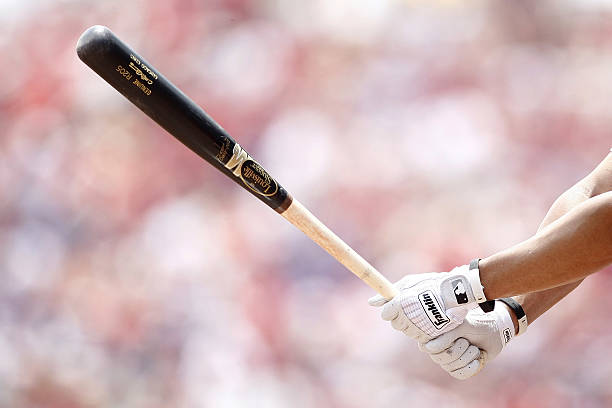In Major League Baseball, General Managers working to build a winning team use WAR as one of their statistical categories when analyzing players.
Writers, voters, statisticians, and fans all use a player’s WAR when looking at their level of success. WAR is also widely used when voting on end of season individual player awards. But what is it? What is WAR in Baseball?
WAR stands for Wins Above Replacement.
“Wins Above Replacement” means just that. How many more wins will this player give a team compared to another player?
That “other” player is called a replacement level player.
WAR = (Batting Runs + Base Running Runs + Fielding Runs + Positional Adjustment + League Adjustment + Replacement Runs) / (Runs Per Win)
That’s a complicated formula. Some of the stats within the formula are not commonly used or seen.
But WARs complicated formula is simple when you have the stats you need.
The formula for WAR accounts for all situations a player can get in to during a baseball game. Batting, Baserunning, and Defense for positional players.
For pitchers it’s Hits, Walks, Hit Batters, K’s, Infield and Outfield Fly Balls, and Innings.
A player’s WAR is used by teams and organizations because the metric measures a player’s value against a replacement level player.
WAR is measuring how much better or worse a player is against an average player in the league.
A replacement level player is the same as a league average player.
WAR asks and answers, “How many more or less wins will this player provide our team compared to a replacement level player?”
There are two separate formulas for WAR however, one for positional players (or batters), and another for pitchers.
We will review pitchers WAR and its formula later, below.
Think of WAR for any position as “Is this player better than the league average player at the same position?”.
The main purpose of WAR is to decipher how many more wins that player is worth than the replacement level player at the same position.
Contents
How to Calculate WAR in Baseball (for position players)
WAR calculations look and can be complicate. The WAR stat is not as simple and straight forward as other stats like batting average, homeruns, era, and WHIP.
With that said, WAR in a way takes all the other stats and combines them to get to one number.
That one number, which is a player’s WAR, is the stat to simply compares one player versus the league’s typical average player at the same position.
How much better is that player at the position than the leagues average player at that position? AKA, a replacement level player.
How do you calculate WAR?
WAR = (Batting Runs + Base Running Runs + Fielding Runs + Positional Adjustment + League Adjustment + Replacement Runs) / (Runs Per Win)
There are 6 components to calculating WAR for positional players:
- Batting Runs (RBI)
- Baserunning Runs (Runs)
- Fielding Runs (Defensive Runs Saved)
- Positional Adjustment
- League Adjustment
- Replacement Level Runs (based on playing time)
Technically, there isn’t an official formula for WAR. Some include an additional component, Runs added or lost due to double plays.
This form of WAR is known as bWAR.
Using the given formula for WAR is how you calculate WAR in baseball. WAR is measured using the WAR formula which combines several other stats to get to one number.
The best place to start when attempting to calculate WAR on your own is have your stats of the 6 components ready, and a calculator.
Or just go to a trusted site with all the data, like Baseball Reference.
Position players have their own formula for calculating WAR, but what about pitchers?
How do I know how much better or worse a pitcher is compared to the league average?
How to Calculate Pitchers WAR in Baseball
Since pitchers have a different set of stats when reviewing their level of success, the same goes for their pitching WAR.
How do you calculate WAR for a pitcher in baseball?
Pitcher WAR = FIP / IP
Calculating WAR can be simple if you know what FIP is. FIP however is more complex.
What is FIP? FIP means Fielding Independent Pitching.
FIP = (Homeruns) + (BB + HBP) + (K + IFFB) / IP
You can also get FIP info from most baseball website, mainly Baseball Reference.
The beauty of FIP is it accounts for all that a pitcher is solely responsible for. Everything a pitcher can control on their own.
WAR statistic for pitchers has two components:
- FIP
- Innings Pitched
FIP however has six components:
- Homeruns allowed (HR)
- Walks (BB)
- Hit by Pitches (HBP)
- Strikeouts (K’s)
- Infield Fly Balls and Fly Balls (IFFB)
- Innings Pitched (IP)
Pitcher WAR is a simpler calculation because once you have FIP, you just take FIP and divide it by innings pitched.
Pitchers WAR is not nearly as common or used as positional player WAR.
What organizations like more from pitchers are the much simpler stats.
ERA, Batting Average Against, K/9, BB rate, and FIP. Pitcher wins have lost a lot of value.
FIP is becoming more popular, as it should be. Pitchers can have a good or bad defense, good or bad offense, but they can’t control that.
They can control what’s included in FIP though. FIP is basically counting what a pitcher does on their own, what they give up and how they get people out.
What is Good WAR in Baseball?
Understanding WAR (Wins Above Replacement) in Baseball is great for having educated baseball conversations. It helps when arguing which player is better than another, or which you’d rather have on your team.
WAR grades a player as a whole, not just as a hitter or just as a defender.
WAR in baseball is a great way to understand how many wins that player helps you achieve compared to replacement level players. A high WAR means more wins.
What is good WAR in Baseball? Are there different levels to WAR? Below is a chart to use as a basic outline of grading a player based on their WAR.
Good WAR in Baseball would be in the 2.1 – 4.9 range, though closer to 4.9 and 5 is better than just “good”.
WAR Player Value Chart
- <0 = Replaceable Player
- 0 – 2 = Backup/Bench Player
- 2.1- 4.9 = Regular Starter
- 5 – 7.9 = All-Star Level Player
- 8+ = MVP Level Player
I remember coaches giving us goals in the dugout, and one of them was “Win your position”. This means a pitcher should strive to out duel the opponent’s pitcher. And position players should strive to player better defensively than their opponent counterpart.
There are many factors in a baseball game that one single player can’t control. Pitcher, catcher, and position players all need to work together.
However, one player can play better than a player on the other team at the same position. This is where WAR value comes in.
That’s winning your position. Organizations, especially Major League Baseball teams, are using this same concept of winning your position by looking at player’s WAR. WAR is very common in Major League Baseball, less common in leagues below. A minor league player is more focused on development, so their WAR isn’t as much of a factor yet.
Baseball writers and voters use the above chart as a starting point when determining a player’s seasonal awards and accolades. Especially for position players in MVP voting.
Any player with a WAR above 5 would be considered a great player.
WAR is also good for free agency. Either for the player who has a good or great WAR seeking a higher contract. Or for General Managers looking at Free Agents and who can help their team win.
Who has the Highest WAR in Baseball?
Asking who has the highest WAR in Baseball History makes more sense to ask per season. The number changes daily as each player plays. WAR is a counting stat, meaning it goes up or down depending on the day. This also changes the WAR of the average major league player. Or, Replacement player.
Career WAR is interesting because it tells you how a player compared to the league replacement player throughout the course of their career. If a player has a high career war, it correlates to that player being better than league average over their career.
To me, WAR is more about the single season currently taking place.
The best way to ask who has the highest WAR in Baseball is to ask this. Who has the highest WAR in Baseball in a single season?
Below is the top 50 single season WAR in Baseball History for Positional Players:
Why is WAR used in Baseball?
WAR is an excellent way to measure a player’s value compared to another player at the same position or the leagues average player at that position. The majority of the time you hear about WAR, it’s in regard to position player WAR. And normally WAR is compared for a single season.
It helps teams evaluate players and build winning rosters. If a team has several players will a WAR above the league averages, it usually has a direct impact on the team’s success.
WAR literally means “Wins Above Replacement”, meaning, how many more wins will this player give us compared to another player?
For example, in 2014 Clayton Kershaw and Mike Trout each won the MVP award in the MLB.
Kershaw winning it as a pitcher is extremely rare, but WAR was the main reason why. In 2014, Kershaw’s WAR was 7.2, meaning the Dodgers won 7 more games because of Kershaw had they had an average player in place of him.
Winning 7 more games by one player played a massive part in the team’s overall success.
The same goes for Mike Trout, who has now had a WAR above 8 for 7 seasons.
We all know Mike Trout is one of the best baseball players of all time, and his WAR backs it up. Having one player get a team 8 more wins for that many season is just incredible.
The beauty of calculating WAR for position players is right there with Trout. Trout is a top-level hitter for average, on base, and power.
He is also a great base runner and defensive outfielder. All that is proven beyond the eye test and homerun and stolen base stats by calculating his WAR.
Check this video out for a good argument on WAR.
Final Word
WAR’s value is immense when building a Major League Baseball roster and for voting on end of season awards. It is also used now for Hall of Fame voting.
WAR = Wins Above Replacement. WAR means how many more (or less) wins does this player provide compared to another player at the same position?
For position players, WAR includes offense, base running, and defense. WAR looks at the player as a whole.
For pitchers, WAR includes FIP and Innings Pitched. All the things a pitcher solely has control of.
Players that win both Silver Slugger and Gold Glove Awards, most likely have a very high WAR.
With all of the baseball anacronyms out there like WHIP, ERA, RBI, etc it can be confusing trying to remember what they each mean.
Now that you know what WAR is and how to calculate it, you can feel confident when arguing who you think is an All-Star, MVP, or which player you want your team to sign or trade for.


